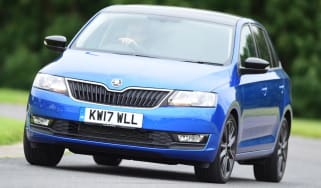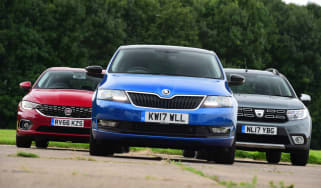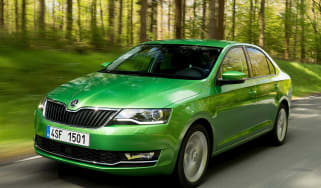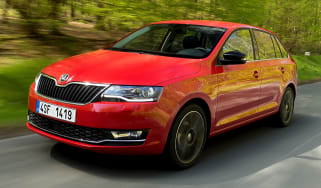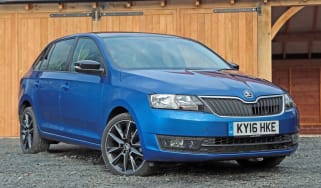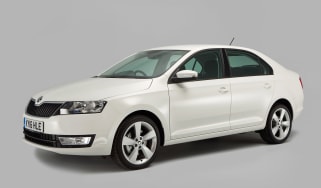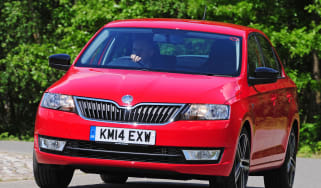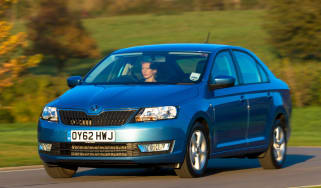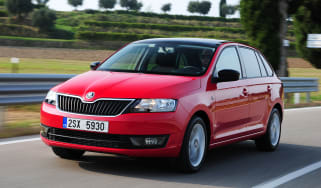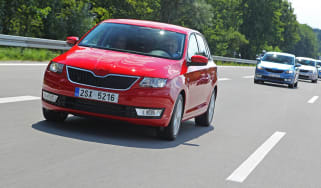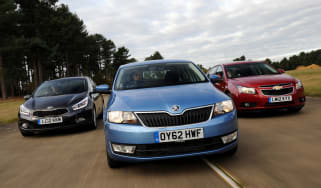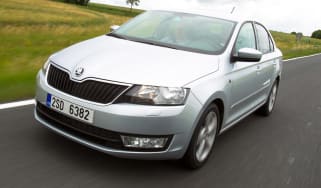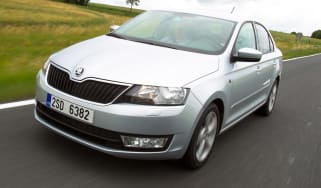Skoda Rapid (2012 to 2019) review
The Skoda Rapid is a rather plain hatchback, but it offers a lot of space for the money

Skoda has always been a brand associated with value, and although prices of cars like the Fabia supermini have steadily crept higher, the Rapid still combines versatility with an affordable price tag.
Thanks to its clever design, it has more interior room than models such the Ford Focus and Volkswagen Golf for a much lower price – the entry level models start at around £15,000.
However, the Rapid is rather docile to drive, and its interior quality and ride comfort aren't up to the high standards found in the Golf or Hyundai i30.
Despite these drawbacks, the Rapid has some great qualities, such as its huge boot and a good range of engines – all of which add up to make it a reasonable choice for families on a budget.
It's a name from the past, but the Skoda Rapid doesn't have anything in common with the old models that have also used it. It's a thoroughly conventional front-wheel drive, five-door hatchback, although it does look like a small saloon from a distance. In terms of size, it sits between the Fabia and Octavia in the range, and it's offered for a price that's more supermini than hatchback.
Under the skin, the Rapid uses a platform and engines that are scavenged from elsewhere within the Volkswagen Group. It's identical to the SEAT Toledo (they're also built in the same factory in the Czech Republic), while the platform is a development of that found under the VW Polo Mk5.
Used - available now

2024 Land Rover
Defender 110
34,823 milesAutomaticDiesel3.0L
Cash £55,500
2022 Kia
Stonic
63,172 milesManualPetrol1.0L
Cash £11,200
2023 Jeep
Avenger Electric
10,145 milesAutomaticElectric
Cash £19,097
2023 Kia
Sportage
14,283 milesAutomaticPetrol1.6L
Cash £28,497An update to the Rapid in 2017 saw the addition of new engines and revised equipment. There are two versions of the 1.0 TSI three-cylinder turbo petrol motor, which come in 95PS and 110PS guises that have 94bhp and 108bhp respectively, while a 1.4 TSI 125PS four-cylinder is also offered with 123bhp and a seven-speed twin-clutch DSG gearbox. This is the only petrol auto you can have in the Rapid, because the 1.0 TSI is only offered with a five or six-speed manual depending on which trim you choose.
Diesel power comes in the shape of 1.4 TDI 90PS and 1.6 TDI 115PS units with 89bhp and 113bhp respectively. They both come with a five-speed manual as standard, while the lower powered engine can be had with the seven-speed DSG auto.
There are four versions of Rapid available - S, SE, SE L and Sport. It's worth noting that you can't get every engine in every trim, while the Sport model - which is similar in spec to Monte Carlo trim on the Fabia - is the only version to get a six-speed manual gearbox,but it only comes with the 1.0 TSI 115PS engine. That's no bad thing, though as it's the model we'd go for.
As well as the standard five-door hatch, Skoda also offers the Rapid Spaceback. This is another five-door hatchback, but it has a slightly tidier look to its rear end thanks to the all-glass tailgate, only marginally less boot space and lower prices.
With prices ranging from around £15,500 to £20,300, the Rapid is a value-driven model, so its most direct rivals are the largely identical SEAT Toledo, the Fiat Tipo and even the Suzuki Baleno large supermini. It can also count entry-level versions of the Vauxhall Astra, Renault Megane and Ford Focus, among others, while the Citroen C4 Cactus is another alternative.
The name Rapid comes from Skoda's past. It was first used on a six-cylinder model that was offered in the 1930s, but it's perhaps more famous as the sporty version of the rear-engined 130 saloon in the Eighties. It gained cult status courtesy of its sporty looks and tail-happy handling that was reminiscent of the Porsche 911, albeit at a far more sedate pace.
Engines, performance and drive
All Skoda Rapid models have modern engines, but the lower-powered versions can feel a little sluggish. However, the car's low kerbweight means it's not much of a hardship.
Washboard roads and harsher bumps or potholes still give a high-frequency patter through the suspension, although the dampers just shave the edge off bigger bumps well. On the motorway the Skoda feels relaxed, while the compromise when it comes to ride quality on country roads helps a little on twisty roads. It won’t set your pulse racing, and the steering is lifeless, but it's not bad considering the budget car roots.
Engines
The Skoda Rapid is available with a choice of small petrol and diesel engines. The smallest is a three-cylinder 1.0-litre petrol TSI unit with 94bhp, which takes a sedate 11 seconds on the sprint to 62mph but can still manage a 116mph maximum. A 108bhp version of the same engine drops the acceleration time down to 9.8 seconds, but it feels faster than the numbers suggest in the real world.
Moving onto the diesels, the line-up kicks off with a three-cylinder 1.4 litre TDI boasting 89bhp that’s available with manual or the DSG gearbox. The manual gives you 0-62mph in 11.7 seconds, and a top speed of 115mph, while opting for DGS loses a tenth in acceleration.
The fastest diesel is the punchier 114bhp 1.6, which has a 0-62mph time of 10 seconds and a 125mph maximum. The 1.6 TDI is quite gruff at idle and gets even noisier if you extend it through the rev range, so it’s best to keep a lid on things and use the 250Nm of torque, where its in-gear performance is acceptable.
MPG, CO2 and Running Costs
The Skoda Rapid is available with a choice of robust petrol and diesel engines, which range from 1.0 to 1.6 litres.
The diesels are the most efficient engines in terms of mpg and emissions, as you’d expect. The 1.4 TDI is cheapest to run, with a 105g/km CO2 rating and a claimed average fuel economy figure of 70.6mpg.
The 114bhp 1.6 TDI is capable of 67.3mpg and emits just 109g/km of CO2, so apart from the higher initial purchase price there’s little financial disincentive to own the bigger diesel if you want better performance.
The 1.0 TSI petrol is smooth and refined, and comes with either 94bhp or 108bhp. The lower-powered version manages 62.8mpg and 103g/km, and the other returns 61.4mpg and 106g/km.
As the petrol engines are pretty efficient, and because the list price for petrol Skoda Rapid models is almost £2,500 less than their diesel equivalents, make sure you cover enough miles annually to make the rattly oil burners worth the extra cost up front.
Our main problem with parting with cash for the Rapid is the existence of the bigger and better Octavia range, which starts at only £1,800 more.
Insurance groups
The Skoda Rapid’s insurance groups run from 13 for the 1.0 TSI petrol up to 18 for a top-spec 1.6-litre diesel version – all pretty competitive.
Depreciation
While some Skodas – such as the Yeti 4x4 – hold onto their value well, others like the Rapid still aren’t finding traction in the used market. According to some industry predictions based on a three-year/30,000 mile ownership cycle, you’ll be lucky to hang onto a third of the original purchase price at resale time.
To get an accurate valuation on a specific model check out our free car valuation tool...
Interior, design and technology
Styling often takes a back seat in the pursuit of versatility and that's definitely the case with the Skoda Rapid.
As with the larger Octavia, the Rapid’s rear end shape comes from its big boot, but unlike a conventional hatchback, the Rapid’s tailgate slopes more gently down to the base of its C-pillars. Despite this bigger hatch opening and long look of the bodywork, the Rapid is actually shorter than most rival hatchbacks, although the Skoda’s overall shape and styling mean this difference isn’t as noticeable when they’re parked side-by-side.
The Rapid conforms to Skoda’s relatively conventional, reserved design, so there aren’t many flourishes to speak of. There are lots of geometric shapes at the front and the Rapid’s main grille and headlights, and lower grille and foglamps, create two strong, wide elements in the front bumper.
Apart from a depression at the bottom of the doors, the crease that connects the headlights to the tail-lamps down the car’s flanks is the Rapid’s only notable detail in profile, while at the rear the C-shaped tail-lights and creases on the bootlid give a little bit more visual interest to what’s an otherwise plain and simple shape.
Although the Rapid pre-dates the firm’s flagship Superb model, Skoda’s value-focused hatchback features a few styling cues similar to the larger, more expensive car inside. The dash top doesn’t drop away towards the sides of the car, remaining almost the same level across the width of the cabin. This accentuates the sense of width and space.
The drawback is that it feels like there’s a lot of low-rent plastic in prominent areas. However, the slabby centre console constructed of unforgiving material still highlights the Rapid’s budget price.
Sat-nav, stereo and infotainment
The Skoda Rapid has a reasonable infotainemnt system. The 6.5-inch screen looks small in the dashboard, and makes pressing the multitude of buttons to control the sat-nav fiddly, since each icon has to be so small to fit on to the display. At least the graphics are clear, bright and easy to understand, and the sat-nav does comes with live traffic updates. There’s even a button at the side of the screen that shows you any traffic jams in your immediate area.
The buttons along the sides of the display make navigating between different screens easy, and the interface is user-friendly, apart from the small size of the buttons. If you add the SmartLink option (which costs around £150), you can use your smartphone with the screen, enabling Android Auto and Apple CarPlay. You can get extra USB ports in the back with the optional multi-device interface, which costs about £120.
Practicality, comfort and boot space
While it lacks a little in quality and driving enjoyment, the Skoda Rapid's practicality completely wipes the floor with the Volkswagen Golf and Ford Focus – primarily because it has such a big boot.
It’s deceptive, as the Rapid hatchback’s saloon-inspired styling doesn’t suggest such a high degree of flexibility.
The Rapid’s driving position is good too, with a full range of adjustments for both seat height and steering wheel, and the simple, uncomplicated dash layout also adds to the straightforward feel.
Comfort and refinement on the move are not class-leading, but the suspension does a decent job of soaking up most of our many tarmac imperfections. Wind and road noise are sufficiently subdued too, so you can put some miles under the wheels without becoming unduly frazzled.
Cabin storage is catered for with large door bins, and the car also has some clever touches such as a boot floor with carpet on one side and rubber on the other - so you can flip it depending on what you’re carrying.
Dimensions and size
The Skoda Rapid competes in the super-competitive family hatchback class, where its dimensions give it a clear advantage. At 4,483mm it’s longer than the 4,360mm Ford Focus and the 4,255mm Volkswagen Golf.
Leg room, head room & passenger space
The cabin is spacious enough for carrying five adults, but it will be a bit of a squeeze for taller passengers in the back. All trim-levels come with ISOFIX-prepared rear seats so you can fit the child seats.
Boot space
With the rear seats in place, the Rapid has 550 litres of space in the boot. This is compared to 363 litres in the Ford and 350 litres in the Golf. When its rear seats are folded flat, the Rapid's boot space increases to a huge 1,490 litres.
The Rapid Spaceback sister car has a more conventional compact hatchback bodystyle, which cuts boot space to 415 litres with the back seats up and 1,380 litres with them folded.
Reliability and Safety
Skoda routinely performs well in our annual Driver Power satisfaction survey, and in 2016 the brand notched up a third place result behind Tesla and Lexus. Its dealers couldn’t match that result for customer service, though, finishing mid-table in 15th position.
More impressively, the Skoda Rapid itself was ranked 14th out of almost 200 cars in the 2015 reliability league, and 78th for build quality. Along with extremely well-rated running costs, where it was ranked 6th, such feedback gave the Rapid a strong 25th place in the overall survey.
As the Rapid uses technology from elsewhere in the VW Group, we would expect it to be extremely reliable. Driven in the manner that its designers intended – which is conservatively - even the wear and tear items should last well. The cabin feels durable and well put together too, so should give years of service.
When the Rapid was crash tested by Euro NCAP in 2012, it received a full five-star rating. Most of this is due to the Rapid’s inherent crash safety, as there’s not much safety kit as standard. Six airbags are fitted, but Skoda’s Front Assist collision warning and autonomous emergency braking system is around £315.
Warranty
The Rapid comes with a three-year warranty, but while the first two years include unlimited mileage there’s a cap of 60,000 in year three. However, you can pay extra to extend the warranty for five years/100,000 miles for around £460.
Servicing
For about £22 per month, Skoda will sell you a maintenance plan that covers servicing and inspections for three years or 30,000 miles. It includes an oil change at 12 months or 10,000 miles, and an inspection service at 24 and 36 months.

